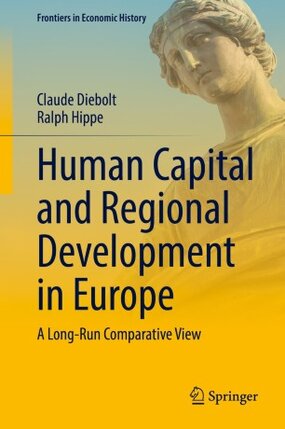Auteurs : Claude DIEBOLT & Ralph HIPPE
Human capital is of utmost importance for the future of our knowledge economies and societies. However, it is unequally distributed in Europe, contributing to marked spatial patterns of economic prosperity within and across countries. In many cases, these patterns have a long history. To understand them better, it requires to go back in time, when mass schooling was starting to become a reality across Europe. Taking a longrun perspective over more than 150 years, this book shows the development and the distribution of human capital in the regions of Europe and its connections with the economy. It provides insights into recent research findings in this area, including theoretical advances and the use of new empirical data.
Introduction
Human capital is a crucial factor to understand regional development. However, while the relevance of human capital is nowadays acknowledged, this has not always been the case. Thus, this chapter indicates the discussions over time on the importance of human capital, and its connection to recent research on regional development. Both theoretical considerations and quantitative measurement are discussed. It further introduces the structure and the chapters of the book.
Regional human capital inequality in Europe
A range of contributions has focused on the international evolution of human capital over the last decades and beyond. However, the regional dimension of human capital in Europe remains insufficiently explored, particularly in a long-run perspective. For this reason, this chapter addresses this gap in the literature and highlights the regional evolution of human capital in Europe between 1850 and 2010 by using numeracy, literacy and educational attainment proxies. The results show that intranational inequalities in human capital have always been important and are in a number of cases more important than international differences. However, a convergence in literacy and educational attainment rates over the respective time periods is found.
Spatial clustering of numeracy and literacy
Studies comparing human capital in (almost) the entire European continent at the regional level are rare. Therefore, we investigate in this chapter the spatial distribution of human capital in Europe in the long run. To this end, the methods of Explanatory Spatial Data Analysis to analyse the spatial heterogeneity of human capital in the European regions are employed by using cross-sectional evidence for 1850 and 1930. The results show a pattern with one core and several periphery clusters. Moreover, spatial clustering persists throughout the time period. Spatial outliers are rather rare. Geographic location and spatial interactions appear to be important for the human capital of a region.
Human capital and market access in the European regions
In a recent contribution, Redding and Schott add human capital to a two sector New Economic Geography model, highlighting that remoteness represents a penalty that gives disincentives to invest in human capital. But is this hypothesis consistent with long-term evidence? This chapter tests the persistence of this effect at the regional level in an historical setting. The results show that market access has a significant positive influence on human capital in OLS, Tobit and IV regression models. Thus, the chapter confirms the ‘penalty of remoteness’ hypothesis for Europe in the long run.
The long-run impact of human capital on innovation and economic growth in the regions of Europe
Human capital is supposed to be an important factor for innovation and economic development. However, the long-run impact of human capital on current innovation and economic development is still a black box, in particular at the regional level. Therefore, this chapter makes the link between the past and the present. Using a large new dataset on regional human capital and other factors in the 19th and 20th century, past regional human capital are found to be a key factor explaining current regional disparities in innovation and economic development.
Lessons from human capital evolution over the last 200 years
Evidence on human capital’s long-run regional development in Europe is still relatively limited. For this reason, this chapter summarises some developments of human capital in the European regions over the last 200 years. It indicates that ‘the long shadow of history’ plays an important role in the regional distribution of human capital. The most advanced regions were typically located in the core industrialised countries, whereas the lowest values of human capital were found in the periphery. Policy makers need to take into account these geographical long-term structures and the vested interests of stakeholders and create a human capital-promoting environment to successfully improve human capital levels.
Conclusion and future directions for research
This chapter concludes the book that has presented new evidence on the long-run evolution of human capital at the regional level, taking a European approach. It discusses newest developments in this area, by explicitly focusing on the impact of the Coronavirus crisis on education. It puts the crisis also into a historical and regional perspective and shows future directions for education and research after COVID19. Better understanding the distribution and the effects of not only basic numeracy, literacy and scientific skills at the regional level but also their relationship with digital skills will be crucial. The crisis should be seen in this light as an opportunity, a wake-up call, that may provide the required stimulus at the policy and research level to investigate further how this new dimension of human capital can shape future regional development in Europe.
Contact : Claude DIEBOLT
Présentation pédagogique des travaux des auteurs (2019) - en langue allemande (avec traduction)



